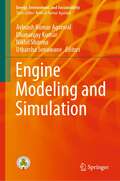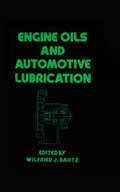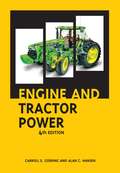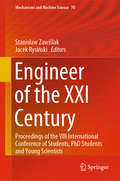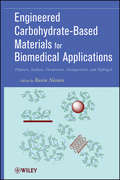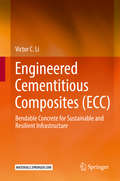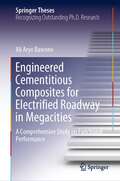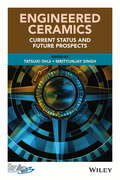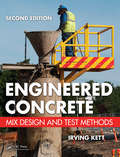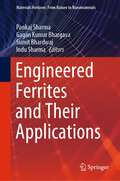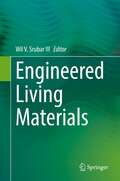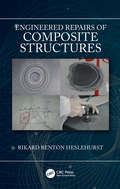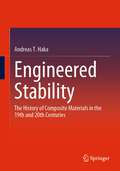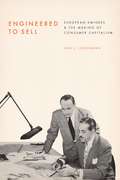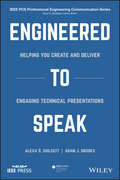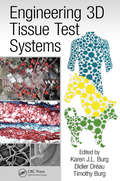- Table View
- List View
Engine Modeling and Simulation (Energy, Environment, and Sustainability)
by Avinash Kumar Agarwal Dhananjay Kumar Nikhil Sharma Utkarsha SonawaneThis book focuses on the simulation and modeling of internal combustion engines. The contents include various aspects of diesel and gasoline engine modeling and simulation such as spray, combustion, ignition, in-cylinder phenomena, emissions, exhaust heat recovery. It also explored engine models and analysis of cylinder bore piston stresses and temperature effects. This book includes recent literature and focuses on current modeling and simulation trends for internal combustion engines. Readers will gain knowledge about engine process simulation and modeling, helpful for the development of efficient and emission-free engines. A few chapters highlight the review of state-of-the-art models for spray, combustion, and emissions, focusing on the theory, models, and their applications from an engine point of view. This volume would be of interest to professionals, post-graduate students involved in alternative fuels, IC engines, engine modeling and simulation, and environmental research.
Engine Oils and Automotive Lubrication (Mechanical Engineering Ser. #80)
by Wilfried J. BartzDiscusses all the major aspects of automotive and engine lubrication - presenting state-of-the-art advances in the field from both research and industrial perspectives. This book should be of interest to mechanical, lubrication and automotive engineers, automotive and machinery designers as well as undergraduate and graduate students in these fields.
Engine and Tractor Power 4th Edition
by Alan C. Hansen Carroll E. GoeringThe text was written for students in colleges of agriculture as well as others with an interest in engines and motor vehicles. Although the primary focus is on engines and farm tractors, many of the concepts also apply to automobiles, trucks, self-propelled farm machinery, lawn and garden tractors, and other vehicles. Updates include new governmental regulations, new technological developments, and illustrations. Chapters include thermodynamics of engines, engine components, engine cycle and timing, power efficiencies, fuels and combustion, electrical systems, ignition circuits, diesel engines, intake and exhaust systems, cooling systems, lubricants, hydraulic systems, power trains and weight transfer, traction and safety.
Engineer Your Own Success: 7 Key Elements to Creating an Extraordinary Engineering Career
by Anthony FasanoFocusing on basic skills and tips for career enhancement, Engineer Your Own Success is a guide to improving efficiency and performance in any engineering field. It imparts valuable organization tips, communication advice, networking tactics, and practical assistance for preparing for the PE exam--every necessary skill for success. Authored by a highly renowned career coach, this book is a battle plan for climbing the rungs of any engineering ladder.
Engineer of Revolutionary Russia: Iurii V. Lomonosov (1876–1952) and the Railways (Science, Technology and Culture, 1700-1945)
by Anthony HeywoodThis book is the first substantial study in any language of one of revolutionary Russia's most distinguished and controversial engineers - Iurii Vladimirovich Lomonosov (1876-1952). Not only does it provide an outline of his remarkable life and career, it also explores the relationship between science, technology and transport that developed in late tsarist and early Soviet Russia. Lomonosov's importance extends well beyond his scientific and engineering achievements thanks to the rich variety and public prominence of his professional and political activities. His generation - Lenin's generation - was inevitably at the forefront of Russian life from the 1910s to the 1930s, and Lomonosov took his place there as one of the country's best known and ultimately notorious engineers. As well as an innovative engineer who campaigned to enhance the role of science, he played a major role in shaping and administering the Russian railways, and undertook several diplomatic and scientific missions to the West during the early years of the Revolution. Falling from political favour during an assignment in Germany (1923-1927), he achieved notoriety in Russia as a 'non-returner' by apparently declining to return home. Thereby escaping probable arrest and execution, he began a new life abroad (1927-1952) which included a research post at the California Institute of Technology in 1929-1930, collaborative projects with the famous physicist P.L. Kapitsa in Cambridge, a long-time association with the Institution of Mechanical Engineers in London, and work for the British War Office during the Second World War. From Marxist revolutionary to American academic, this study reveals Lomonosov's extraordinary life. Drawing on a wide variety of official Russian sources, as well as Lomonosov's own diaries and memoirs, a vivid portrait of his life is presented, offering a better understanding of how science, technology and politics interacted in early-twentieth-century Russia.
Engineer of the XXI Century: Proceedings of the VIII International Conference of Students, PhD Students and Young Scientists (Mechanisms and Machine Science #70)
by Stanisław Zawiślak Jacek RysińskiThis book gathers the proceedings of “Engineer of the XXI Century: The VIII Inter-University Conference of Students, PhD Students and Young Scientists”, which was held at the University of Bielsko-Biała (ATH), Poland, on the 8th of December 2017. The event highlighted outstanding research on mechatronics in the broadest sense, while also promoting cooperation among students and young scientists from around the globe. Topic areas covered include: mechanics and machine building, automation and robotics, mechatronics, production engineering and management, and informatics/computer science.
Engineered Antimicrobial Surfaces (Materials Horizons: From Nature to Nanomaterials)
by Sabu Thomas Nandakumar Kalarikkal S. Snigdha E. K. RadhakrishnanThis volume looks at the different aspects involved in controlling microbial growth and the techniques employed in obtaining sterile surfaces. It covers research on coatings, nano-materials, herbal materials, naturally occurring antimicrobials in designing antimicrobial surfaces. It discusses issues of antibiotic resistance, synthesis techniques, toxicity, and current and potential applications of antimicrobial surfaces, and this book will serve as a useful reference to a broad range of scientists, industrial practitioners, graduate and undergraduate students, and other professionals in the fields of polymer science and engineering, materials science, surface science, bioengineering and chemical engineering.
Engineered Bamboo Structures
by Yan XiaoBamboo is in the spotlight as a potential building material in the current pursuit of a CO2-neutral society, due to its rapid maturation and excellent mechanical properties. Despite the growing interest in bamboo in academia and society, there is a lack of systematic understanding of the fabrication, design and construction processes using bamboo as a modern industrial material. This is the first book to describe a new category of structural systems constructed with engineered bamboo. It gives a definition of engineered bamboo (glubam) in an analogy with steel structures and wood structures. Structural systems and components have been designed using glubam; then industrialized production processes of glubam are described. Based on state-of-the-art research, design guidelines are suggested, in a comparable and parallel approach to the existing guidelines for composite wood structures. The book also discusses bamboo structures in the context of sustainable development, including the benefits of using bamboo as an alternative or replacement for wood, especially for developing countries, many of which are faced with the lack or destruction of forest resources.
Engineered Biochar: Fundamentals, Preparation, Characterization and Applications
by Dinesh Mohan Sudipta Ramola Ondrej Masek Ana Méndez Toshiki TsubotaThis book systematically covers the fundamentals and applications of modified biochar. The 19 chapters are divided into 3 sections that provide a holistic overview for researchers from all related fields. Section 1 and 2 present the pyrolysis process, including the advantages and limitations of the physical, chemical, and biological modification methods and characterization of modified biochar. Section 3 highlights the wide spectrum of applications of modified biochar in fuel cells and batteries, remediation of organic and inorganic contaminants from soil and water and soil fertilization. Given its scope, the book appeals to a broad readership in various fields of chemical engineering, materials science, and environmental science.
Engineered Biomaterials: Synthesis and Applications (Engineering Materials)
by Rishabha Malviya Sonali SundramThis book highlights recent advances focusing on the synthesis methods of engineered biomaterials and their applications. The book discusses recent applications of various approaches and technology in improving the functional properties and biological activities of biopolymers. It includes two major sections: the first section introduces a range of methods which lead to materials with enhanced properties for a range of practical applications, along with the positives and limitations of the techniques. The second section covers recent trends and advances in application of engineered biomaterials that assist materials scientists and researchers in mapping out the future of these new improved materials through value addition in order to enhance their use. Contributions in the book are done by prominent researchers from industry, academia, and government/private research laboratories across the globe. The book summarizes in a fairly comprehensive manner many of the recent technical advancements in the area of biopolymers. The book is intended to serve as a reference resource in the area of polymers science.
Engineered Carbohydrate-Based Materials for Biomedical Applications
by Ravin NarainThis book addresses the need for a comprehensive book on the design, synthesis, and characterization of synthetic carbohydrate-based polymeric materials along with their biological applications. The first two chapters cover the synthesis and self-assembly of glycopolymers and different techniques for creating these synthetic polymers. Subsequent chapters account for the preparation of block copolymers, branched glycopolymers, glycosurfaces, glycodendrimers, cationic glycopolymers, bioconjugates, glyconanoparticles and hydrogels. While these chapters comprehensively review the synthetic and characterization methods of those carbohydrate-based materials, their biological applications are discussed in detail.
Engineered Cell Manipulation for Biomedical Application
by Misturu Akashi Takami Akagi Michiya MatsusakiThis book is the first to summarize new technologies for engineered cell manipulation. The contents focus on control of cellular functions by nanomaterials and control of three-dimensional cell-cell interactions. Control of cellular functions is important for cell differentiation, maturation, and activation, which generally are controlled by the addition of soluble cytokines or growth factors into cell culture dishes. Target antigen molecules can be efficiently delivered to the cytosol of the dendritic cells using the nanoparticle technique described here, and cellular functions such as dendritic cell maturation can be controlled easily and with precision. This book describes basic preparation of the nanoparticles, activation control of dendritic cells, immune function control, and in vivo application for various vaccination systems. The second type of control,that of cell-cell interaction, is important for tissue engineering in order to develop three-dimensional cellular constructs. To achieve in vitro engineering of three-dimensional human tissue constructs, cell-cell interaction must be controlled in three dimensions, but typical biological cell manipulation technique cannot accomplish this task. An engineered cell manipulation technique is necessary. In this book the authors describe the fabrication of nanofilms onto cell surfaces, development of three-dimensional cellular multilayers, and various applications of the cellular multilayers as three-dimensional human models. This important work will be highly informative for researchers and students in the fields of materials science, polymer science, biomaterials, medicinal science, nanotechnology, biotechnology, and biology.
Engineered Cementitious Composites (ECC): Bendable Concrete for Sustainable and Resilient Infrastructure
by Victor C. LiThis is the first book on Engineered Cementitious Composites (ECC), an advanced concrete material attracting world-wide attention in both the academic community and in industry. The book presents a comprehensive coverage of the material design methodology, processing methodology, mechanical and durability properties, smart functions, and application case studies. It combines effective use of illustrations, graphical data, and tables. It de-emphasizes mathematics in favor of physical understanding. The book serves as an introduction to the subject matter, or as a reference to those conducting research in ECC. It will also be valuable to engineers who need to quickly search for relevant information in a single comprehensive text.
Engineered Cementitious Composites for Electrified Roadway in Megacities: A Comprehensive Study on Functional Performance (Springer Theses)
by Ali Aryo BawonoThis book describes the development of an innovative solution for electrified roadway pavements based on engineered cementitious composites, which are exhibiting an extreme tensile strain capacity that is much higher than conventional concrete. This enables the pavement to work without steel reinforcement and to embed a dynamic wireless power transfer technology for charging electric vehicles. At first, the book presents a modified performance-driven design approach to improve the composites to achieve the optimum pavement design in terms of functional and structural performance. It shows that the modified composites can be used to fulfil the safety and comfort factors without neglecting the characteristics of conventional ones. Further, 3D finite element and fluid dynamics models are used to analyse the pavement properties. The validated models can predict the functional performance, including skid resistance, surface water drainage, and noise. In the remaining part of the thesis, an environmentally-friendly photocatalytic function for pavement made of engineered cementitious composites is investigated. In turn, a multi-criteria design analysis is proposed to identify the optimum functional performance of the pavements. All in all, this book reports on a comprehensive approach to design, analyse and optimize engineered cementitious composites for electrified road pavement application. A special emphasis is given on applications in Singapore and other tropical megacities.
Engineered Ceramics
by Mrityunjay Singh Tatsuki OhjiIn this book project, all the American Ceramic Society's Engineering Ceramics Division Mueller and Bridge Building Award Winners, the ICACC Plenary Speakers and the past Engineering Ceramics Division Chairs have been invited to write book chapters on a topic that is compatible with their technical interests and consistent with the scope of the book, which is to focus on the current status and future prospects of various technical topics related to engineering ceramics, advanced ceramics and composite materials. Topics include: *Mechanical Behavior and Performance of Ceramics & Composites *Non-Destructive Evaluation and Mechanical Testing of Engineering Ceramics *Brittle and Composite Material Design *Modern Fracture Mechanics of Ceramics * Thermal/Environmental Barrier Coatings *Advanced Ceramic Coatings for Functional Applications *Advanced Ceramic Joining Technologies *Ceramics for Machining, Friction, Wear, and Other Tribological Applications *Ceramic Composites for High-Temperature Aerospace Structures and Propulsion Systems *Thermal Protection Materials: From Retrospect to Foresight *Carbon/Carbon Composites *Ceramic-Matrix Composites for Lightweight Construction *Ultra High-Temperature Ceramics (UHTC) * Nanolaminated Ternary Carbides and Nitrides (MAX Phases) * Ceramics for Heat Engine and Other Energy Related Applications * Solid Oxide Fuel Cells (SOFC) * Armor Ceramics *Next Generation Bioceramics * Ceramics for Innovative Energy and Storage Systems * Designing Ceramics for Electrochemical Energy Storage Devices * Nanostructured Materials and Nanotechnology * Advanced Ceramic Processing and Manufacturing Technologies * Engineering Porous Ceramics * Thermal Management Materials and Technologies * Geopolymers * Advanced Ceramic Sensor Technology * Advanced Ceramics and Composites for Nuclear and Fusion Applications * Advanced Ceramic Technologies for Rechargeable Batteries
Engineered Concrete: Mix Design and Test Methods, Second Edition
by Irving KettThis book provides a fundamental understanding of cement and concrete, presents an in-depth analysis of mixing and testing methods, and offers minimum coverage of theory. Although focusing mainly on Portland cement concrete, which is perhaps the most important material of modern building construction, the text also includes information on other hydraulic materials and additives with modern applications. This second edition features new chapters that cover the latest concrete technologies: high-performance and lightweight concrete. The author includes new tests and sample tear sheets, additional and updated data sheets in the appendix, and numerous updates throughout the text.
Engineered Ferrites and Their Applications (Materials Horizons: From Nature to Nanomaterials)
by Pankaj Sharma Gagan Kumar Bhargava Sumit Bhardwaj Indu SharmaThis book edited by leading experts focuses on the foundation of ferrite materials since inception to its contemporary scenario including their vast applications. The contents range from the basic physics and chemistry of ferrites to its applications in telecommunication, SAR reduction, EMI shielding, hyperthermia treatment, and water decontamination. It also focuses on ferrite nanoparticles for sensing application, energy-storage applications, antimicrobial applications, corrosion protection applications, among others. This book is a useful reference to those in academia and industry.
Engineered Living Materials
by Wil V. SrubarThis book will serve as a primer for readers to understand recent advances, applications, and current challenges in the field of Engineered Living Materials. The chapters cover core science and engineering research areas, including (1) advances in synthetic biology and genetic programmability for Engineered Living Materials, (2) functional Engineered Living Material for application in energy, electronics, and construction, and (3) novel manufacturing approaches for Engineered Living Materials at multiple scales. The emerging field of Engineered Living Materials represents a significant paradigm shift in materials design and synthesis, in which living cells are used to impart biologically active functionalities to manmade materials. The result is a genetically programmable augmentation of non-living matter to exhibit unprecedented life-like (i.e., living) capabilities. At the intersection of synthetic biology and materials science, the field of Engineered Living Materials exhibits unprecedented promise and potential to alter the way we synthesize new materials and design medical devices, fabrics, robotics, commodity polymers, and construction materials. Materials with attributes of living systems can be engineered with an ability to respond to their environment and designed to self-repair in response to physical or other stresses or detect the presence of specific stimuli, such as light, heat, pressure, or hazardous chemical compounds. Although nascent, scientists and researchers in the field of Engineered Living Materials have made marked advances in demonstrating a potential to revolutionize a multitude of science and engineering disciplines. This volume will define the current state of the art of Engineered Living Materials, and highlight grand opportunities and challenges that abound at the nexus of synthetic biology and materials science and engineering.
Engineered Nanomaterials for Innovative Therapies and Biomedicine (Nanotechnology in the Life Sciences)
by Ram Prasad Mahesh Narayan Anand Krishnan Hemen Sarma Sonam GuptaResearch on biomedical applications of nanomaterials has exhibited the rapidly evolving field of biomedical sciences by showing how effective they are in treatment. These particles hold considerable potential for biomedical applications. Work is ongoing, and the results suggest a possibility for a sustainable future for nanomaterials in both therapeutic and biomedical fields. This book highlights current and emerging applications, taking global research findings into consideration. We believe the focus on the identification and role of nanomaterial applications in therapeutic and biomedical sciences can lead to novel solutions in the fields. The chapters of this book are disseminated in a manner that can be readily adopted as sources for new and further study. The editors integrate advanced texts in their research that help graduate students, researchers and professors. Additionally, we believe that international readers will be able to make use of this book for reference purposes.
Engineered Nanoparticles as Drug Delivery Systems (Emerging Materials and Technologies)
by Anjana Pandey Nahid RehmanThis book highlights application of nanomaterials for drug delivery, therapy, and engineering. It covers stimuli-sensitive drug delivery systems including an overview of the physical, chemical, biological, and multi-stimuli-responsive nanosystems. It also presents analysis of clinical status for different types of nanoplatforms and assesses novel applications of nanomaterials in the areas of smart delivery and drug targeting. It further discusses the advantages and disadvantages of each application of pertinent nanomaterials. Features: Provides academic introduction to the uses of nanotechnology in drug delivery. Discusses use of nanomaterials in targeting a drug to specific tissues and cells. Presents an analysis of clinical status for different types of nanoplatforms. Covers applications in drug delivery, therapy, and engineering. Focuses on how novel nanotechnology-orientated methods can help improve treatment. This book is aimed at researchers and graduate students in biomedical and biochemical engineering, pharmaceutical, chemical and bioprocess engineering, materials science, and drug delivery mechanisms.
Engineered Repairs of Composite Structures
by Rikard Benton HeslehurstEngineered Repairs of Composite Structures provides a detailed discussion, analysis, and procedures for effective and efficient repair design of advanced composite structures. It discusses the identification of damage types and the effect on structural integrity in composite structures, leading to the design of a repair scheme that focusses on the restoration of the structural integrity and damage tolerance. This book teaches the reader to better understand effective and efficient repair design, allowing for more structurally effective repairs of damaged composite structures. It also discusses the application of the repair and what is needed in the forming of the composite repair to meet the engineering design requirements. Aimed at materials engineers, mechanical engineers, aerospace engineers, and civil engineers, this practical work is a must have for any industry professional working with composite structures.
Engineered Stability: The History of Composite Materials in the 19th and 20th Centuries
by Andreas T. HakaHow long have composites been around? Where does the classical laminate theory come from? Who made the first modern fiber composite? This work in the history of materials science is the first examination of the strategies employed in the nineteenth and twentieth centuries in researching and developing hybrid materials. The author analyzes numerous sources which record a regular back and forth between applied design and exploratory materials engineering in building such “modular materials”. The motivations, ideas, and concepts of engineers, scientists, and other players in industry and research are also examined within the context of their day. This book presents the development and importance of composite materials within historical context.The content includesEarly composite materialsThe development of composite materials in the industrial nineteenth centuryComposites in twentieth-century polymer chemistryThe development of hybrid material systems in the second half of the twentieth centurySummary.The author:Dr. Andreas T. Haka is an engineer and historian of science and technology. He is currently a lecturer in the Section for the History of Science and Technology at the University of Stuttgart. His main focus is on the history and practice of materials research, raw materials, materials science and technological constructive design, scientific networks, and research technologies.
Engineered to Sell: European Émigrés and the Making of Consumer Capitalism
by Jan L. LogemannThe mid-twentieth-century marketing world influenced nearly every aspect of American culture—music, literature, politics, economics, consumerism, race relations, gender, and more. In Engineered to Sell, Jan L. Logemann traces the transnational careers of consumer engineers in advertising, market research, and commercial design who transformed capitalism from the 1930s through the 1960s. He argues that the history of marketing consumer goods is not a story of American exceptionalism. Instead, the careers of immigrants point to the limits of the “Americanization” paradigm. Logemann explains the rise of a dynamic world of goods and examines how and why consumer engineering was shaped by transatlantic exchanges. From Austrian psychologists and little-known social scientists to the illustrious Bauhaus artists, the emigrés at the center of this story illustrate the vibrant cultural and commercial connections between metropolitan centers: Vienna and New York; Paris and Chicago; Berlin and San Francisco. By focusing on the transnational lives of emigré consumer researchers, marketers, and designers, Engineered to Sell details the processes of cultural translation and adaptation that mark both the midcentury transformation of American marketing and the subsequent European shift to “American” consumer capitalism.
Engineered to Speak: Helping You Create and Deliver Engaging Technical Presentations (IEEE PCS Professional Engineering Communication Series)
by Adam J. Brooks Alexa S. ChilcuttEngineered to Speak: Helping You Create and Deliver Engaging Technical Presentations Technical expertise alone is not enough to ensure professional success. Twenty-first century engineers and technical professionals must master making the complex simple and the simple interesting. This book helps engineers do what they love most: take a complicated system and create a stronger solution. You will learn tips and strategies that help you answer one essential question, “How can I get better at sharing my ideas with a variety of audiences?” In Engineered to Speak, Alexa Chilcutt and Adam Brooks combine their expertise in messaging and public speaking with research that illustrates how effective communication contributes to career advancement. Each chapter contains inspiring stories from practicing engineers around the world as well as useful examples, exercises and repeatable processes for creating compelling messages. This book helps technical talent become better speakers, better communicators, and ultimately better leaders. This helpful guide demystifies the art of oral communication by breaking it down into ten easy-to-follow-processes that can improve the ability of professionals at any level. By the end of Engineered to Speak, you’ll understand how to gain buy-in, identify and expand your Sphere of Influence, amplify your message, deliver compelling presentations, and learn from those who’ve embrace these skills and enjoyed professional success.
Engineering 3D Tissue Test Systems
by Karen J. L. Burg, Didier Dréau and Timothy BurgEngineering 3D Tissue Test Systems provides an introduction to, and unique coverage of, a rapidly evolving area in biomaterials engineering. It reveals the current and future research responses, the current and future diagnostic applications, and provides a comprehensive overview to foster innovation. It offers insight into the importance of 3D systems and their use as benchtop models, spanning applications from basic scientific research to clinical diagnostics. Methods and limitations of building 3D tissue structures are evaluated, with attention given to the cellular, polymeric, and fabrication instrumentation components. The book covers the important aspects of polymeric tissue test systems, highlighting the needs and constraints of the industry, and includes a chapter on regulatory and pricing issues.
